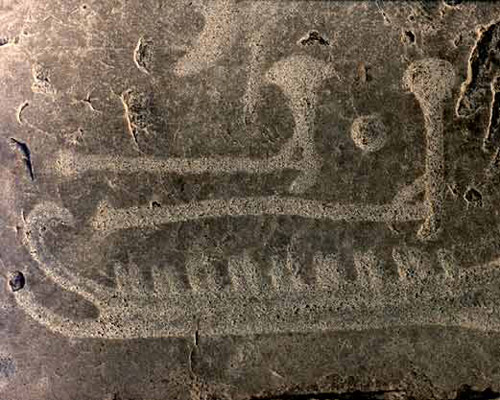| Helleristninger

| | Helleristninger, det vil sige tegn eller billeder indhugget i sten findes i hele Sydskandinavien, men også andre steder i Europa. De dateres til at være tilhuggede i perioden yngre stenalder og bronzealderen.
I Øresundsregionen er der fundet en hel del billedhelleristninger i Simrishamn i Skåne og på Bornholm. |
Hvad er Helleristninger?
Helleristninger er billeder og tegn, som i forhistorisk tid blev indhugget og indslebet på heller, det vil sige glatte sten og klippeflader. Fænomenet kendes fra store dele af verden til forskellig tid. I Norden findes de ældste helleristninger i Norge og i Mellemsverige.
I Sydskandinavien er den overvejende del af helleristningerne udført i bronzealderen; af disse udgør skålformede fordybninger halvdelen, blandt resten dominerer stiliserede skibsbilleder. Menneskefremstillinger gengives ofte i situationer, der afspejler bronzealderens frugtbarhedskult.
Skålgrupperne
De såkaldte ”skålgruber”, runde fordybninger indhugget i sten, er den ældste form for helleristninger, vi kender, og de findes på begge sider af Øresund. Betydningen er usikker. På mange dysser og jættestuer fra yngre stenalder, bondestenalderen, kan man se skålgruber indhugget i dækstenenes overside. F.eks. i dysserne i skovene omkring Helsingør: Klosterris Hegn og Horserød Hegn.
Og på den statelige Snarringedysse ved Skegrie mellem Malmø og Trelleborg findes f.eks. ikke mindre end 268 skålgruber indhugget i en af dækstenene.
Skålgruber kan også findes på løse sten og på klippesider. I Skåne findes der mange koncentrationer specielt i landskabets nordvestre og nordøstre hjørne.
Skålgruberne kan dateres til slutningen af bondestenalderen og bronzealderen. Et af de ældste daterbare fund af skålgruber i Norden er gjort i Fosie i Malmø. En kvinde tilhørende den såkaldte ”stridsøksekultur” havde i sin grav fra 2.300 f.Kr. fået en større rund sten med to indhuggede skålgruber med sig.
Billederne
Helleristninger i form af billeder findes i store mængder nær ved Simrishamn i sydøstre Skåne samt på Bornholms nordlige del. Områderne Järrestad, Simrislund i Skåne og Allinge på Bornholm er kendte navne for folk, der interesserer sig for helleristninger. Her findes et utal af skibe, okser, fodaftryk m.m.
Tolkning af "Den dansende mand fra Järrestad"
I Järrestad findes der en helleristning af en mærkelig mand. Benene er dobbelt så lange som kroppen, og hovedet med to horn er ekstremt lille.
Hvad gør hornene på denne figur? Det ser ud som om, de sidder fast på en hjelm, eftersom bronzealderfolket faktisk havde horn på deres hjelme. På Nationalmuseet i København findes der to helt unikke bronzehjelme, der understøtter en sådan antagelse. To høje, buede bronzehorn sidder fast på museets hjelme. Forsiden på hjelmen er endvidere udformet som et ansigt; med øjne, øjenbryn og en kroget næse. En sådan hjelm har givetvis ikke haft nogen praktisk funktion som personbeskyttelse i en kampsituation. Der må være tale om en ceremoniel funktion.
Den dansende mand fra Järrestad har kraftige og markerede underben. Dette er ikke usædvanligt for helleristninger fra bronzealderen og tolkes ofte, som at danseren har haft benskinner eller læderskinner påmonteret til beskyttelse af sine skinneben.
Manden har desuden et bronzesværd hængende fra midjen.
At vi her står overfor et religiøst billede fremgår af den måde, som manden gengives: Begge hans hænder er strakt ud i en tilbedende position.

Simrislund | 
Järrestadsskib | 
Järrestad | 
Järrerstadsdanseren | 
Fortidsspor |
Stridsvogne
En anden spændende helleristning findes i Frännarp, ca. tre mil nord for Kristianstad i Skåne. Her har man i en klippe indhugget billeder af en mængde stridsvogne. Disse vogne er direkte kopier af de stridsvogne man kender fra Egypten og Grækenland fra ca. 1400 f.Kr. Frännarps-ristningen tyder på, at der i bronzealderen har været forbindelser til lande langt sydpå.
Det samme gælder for den berømte Kiviksgrav. Et stort antal ristede stene viser selve helkisten i gravens midte. På en af stenene ser man en mand, som kører en stridsvogn, draget af to heste.

Stridsvogn | 
Kiviksgraven |
|